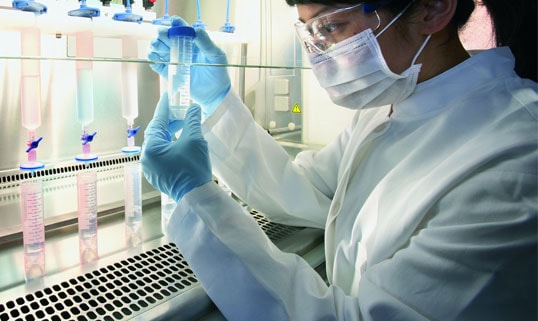HCT116-eGFP-Puro
- Frozen / Standard (CL063-STAN) $ 1,500
Species: Human
Cell type: Colorectal carcinoma
Transgenes: Enhanced green fluorescent protein (eGFP) with puromycin resistance for selection with puromycin
Media: DMEM, 10% FBS, 1% Pen/Strep, 1μg/mL puromycin
Description: HCT116-eGFP-Puro is a polyclonal population of the human colorectal carcinoma cell line HCT116 (ATCC® CCL-247™) transduced with LV-eGFP-PGK-Puro (LV031) encoding enhanced green fluorescent protein (eGFP) cDNA under the SFFV promoter and the puromycin resistance gene (Puro) under the PGK promoter.
The lentiviral vector used is a self-inactivating (SIN) vector in which the viral enhancer and promoter has been deleted. Transcription inactivation of the LTR in the SIN provirus increases biosafety by preventing mobilization by replication competent viruses and enables regulated expression of the genes from the internal promoters without cis-acting effects of the LTR (Miyoshi et al., J Virol. 1998).
Mycoplasma Testing: This cell line has been tested for mycoplasma contamination and is certified mycoplasma free.
Cell Line Authentication: Authentication of the parental HCT116 cell line was performed by short tandem repeat (STR) profiling with 9 STR loci including CSF1PO, D13S317, D16S539, D5S818, D7S820, TH01, TPOX, vWA and sex chromosome marker Amelogenin. STR profiling of HCT116 cells are verified and there is no interspecies cross contamination detected.
Recommended uses:
In vitro: This is a high eGFP expressing clone suitable for use as a positive control cell line in fluorescence assays to validate GFP expression in your lentiviral transduced cells.
In vivo: This human colorectal cell line grows as xenografts in immunocompromised mice. Note: In life optical imaging GFP fluorescence is not recommended due to high background autofluorescence. Tissues may be harvested post mortem for analysis by conventional microscopy.
For in vivo imaging, please use the human NIS reporter gene for high resolution 3D imaging.
References on NIS imaging:
1. Fruthwirth et al. A whole body dual modality radionuclide optical strategy for preclinical imaging of metastasis and heterogeneous treatment responses in different. microenvironments. J. Nucl. Med 2014. 55(4): 686-94.
2. Penheiter et al. The sodium iodide symporter (NIS) as an imaging reporter for gene, viral and cell-based therapies. Curr Gene Ther. 2012, 12(1):33-47.
Morphology: Low- and high-density cell morphology (200x)

Transgene Validation:
Flow cytometry of HCT116-eGFP-Puro for GFP expression (green) versus control (gray) cells.

Publications that used associated reagents:
LV-eGFP-PGK-Puro (LV031): Shen et al. Immunovirotherapy with vesicular stomatitis virus and PD-L1 blockade enhances therapeutic outcome in murine acute myeloid leukemia. Blood. 2016. March 17: 127(11): 1449-58.

